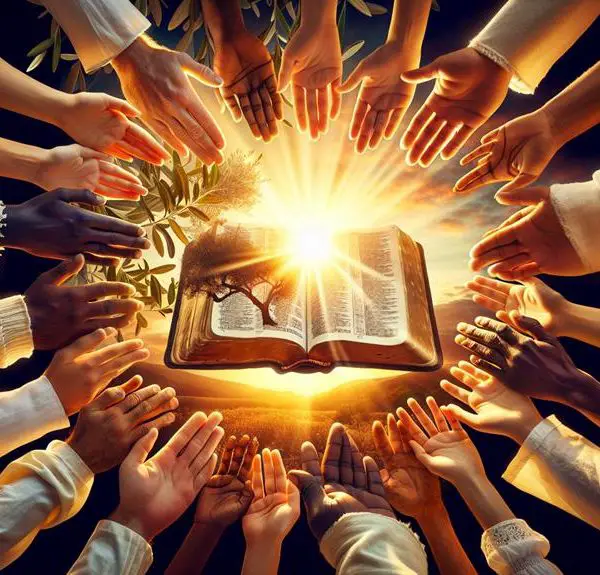Learn the differing perspectives of Jesus' Transfiguration in Matthew, Mark, and Luke, unveiling a multifaceted divine revelation that beckons deeper exploration.

Where Is Transfiguration in the Bible
Just as a mountain offers different vistas depending on one's vantage point, so too does the story of the Transfiguration unveil varied perspectives across the Gospels of Matthew, Mark, and Luke.
You'll find this pivotal event detailed in Matthew 17:1-8, Mark 9:2-8, and Luke 9:28-36, each account providing unique insights and nuances that enrich our understanding.
As you explore these passages, you're invited to consider not only the historical and theological significance but also what these diverse narratives reveal about the nature of divine revelation.
This journey promises to deepen your appreciation for this transformative moment in the life of Jesus, leaving you with more questions than answers and a curiosity to uncover the layers of meaning contained within.
Key Takeaways
- The Transfiguration is narrated in the New Testament Gospels of Matthew (17:1–9), Mark (9:2–8), and Luke (9:28–36).
- Each Gospel account emphasizes Jesus' divine glory, with Peter, James, and John as witnesses.
- Matthew's account uniquely adds the directive "listen to him," underlining Jesus' supreme authority.
- The event symbolically unites the law (Moses) and prophets (Elijah) in Jesus, affirming his messianic identity.
Understanding Transfiguration

To grasp the concept of Transfiguration within Christian theology, it's essential to understand its depiction as a pivotal event in the New Testament, where Jesus is transfigured and becomes radiant upon a mountain in the presence of Peter, James, and John. This moment holds profound significance, not only in its immediate narrative impact but also in its historical context and cultural interpretations that have evolved over centuries.
Delving into the historical context, you'll find that the Transfiguration bridges the Old and New Testaments, symbolically uniting the law (Moses) and the prophets (Elijah) with the fulfillment of both in Jesus Christ. This event isn't just a miraculous occurrence but a revelation of Jesus' divine nature to his closest disciples, affirming his messianic identity at a crucial point in his ministry. It's a moment that firmly roots Jesus within the prophetic traditions of Judaism while simultaneously setting the stage for the establishment of a new covenant.
Cultural interpretations of the Transfiguration have varied widely, reflecting the diverse theological emphases of different Christian traditions. In Eastern Orthodoxy, for instance, the Transfiguration is celebrated with great solemnity, emphasizing the theosis or divinization of humanity. In contrast, Western Christianity has often focused on the Transfiguration as a prefiguration of the resurrection of Christ, highlighting themes of glory and divine revelation.
Through these lenses—historical context and cultural interpretations—the Transfiguration stands as a multifaceted event that encapsulates key theological concepts, including revelation, fulfillment, and the bridging of divine and human natures. Understanding this event's rich layers offers deep insights into its lasting significance in Christian thought.
The Gospel of Matthew's Account
In the Gospel of Matthew, the account of the Transfiguration reveals a pivotal moment where Jesus' divine glory is unveiled to Peter, James, and John on a high mountain, underscoring its theological significance within Christian tradition. This narrative isn't merely a display of supernatural phenomena but is rich with symbolic elements that resonate deeply with the foundations of faith.
Moses' appearance alongside Jesus during the Transfiguration is particularly noteworthy. It's not only a testament to Jesus' fulfillment of the Law, represented by Moses, but it also serves as a bridge connecting the Old and New Testaments. Moses, having once encountered God on Mount Sinai, now appears in a glorified state, suggesting the continuity and fulfillment of God's covenant with Israel in the figure of Jesus.
Elijah's role in this event is equally significant. Representing the prophets, his presence alongside Moses underscores Jesus as the culmination of prophecy and the Law. Elijah, expected to return before the coming of the Messiah, stands as a testament to Jesus' messianic identity. This encounter on the mountain thus reaffirms Jesus as the central figure in God's salvific plan, intertwining the prophetic traditions with the revelation of Christ's divine nature.
The Transfiguration in Matthew's account is a theologically dense episode that articulates Jesus' unique status as the Son of God. It's a narrative that not only reveals the glory of Christ to the disciples but also to you, the reader, inviting a deeper understanding of Jesus' role in the fulfillment of divine promise and prophecy.
Insights From Mark's Narrative

You'll find that Mark's narrative offers a distinctive perspective on the Transfiguration, emphasizing aspects not as pronounced in other Gospels.
He employs symbolism to deepen the understanding of this pivotal event, highlighting its theological implications.
Mark's Unique Perspective
Mark's narrative offers a distinctive perspective on the Transfiguration, emphasizing aspects that uniquely contribute to our understanding of this pivotal event. His authorship and narrative style bring forth insights that are:
- Concise and Immediate: Mark's account is notably succinct, driving straight to the heart of the event without the embellishments found in other accounts.
- Vivid Imagery: He uses striking visual descriptions that paint a clear picture of the Transfiguration, making it easily imaginable for the reader.
- Emphasis on Reaction: Mark focuses on the disciples' reactions, providing a human element to the divine event.
- Theological Insights: Through subtle cues, Mark's narrative offers theological insights that speak to the identity and mission of Jesus, enriching our understanding beyond the mere event.
This analytical approach highlights how Mark's unique perspective enriches the biblical narrative of the Transfiguration.
Symbolism in Transfiguration
Delving into the symbolism of the Transfiguration, as depicted by Mark, reveals layers of meaning that deepen our comprehension of this transformative event. You'll find that the mystical transformation of Jesus on the mountain isn't just a miracle; it's a profound symbol of spiritual elevation.
This moment signifies not only Jesus's divinity but also his role as a bridge between the human and divine realms. Mark's narrative, rich in symbolic imagery, underscores the significance of this event.
The dazzling white of Jesus's garments, for instance, isn't merely a detail; it symbolizes purity and the light of divine revelation. Through this lens, the Transfiguration becomes a metaphor for your own potential spiritual awakening, inviting you to seek a closer connection with the divine.
Luke's Depiction Explored
In Luke's depiction of the Transfiguration, you'll find the scene's setting meticulously detailed, offering a vivid backdrop to this pivotal event.
The apostles' reactions are highlighted, providing insight into their understanding and the event's impact on them.
Furthermore, Luke's narrative invites you to consider the theological implications, emphasizing the significance of this moment in the broader biblical context.
Scene's Setting Detailed
Luke's account of the Transfiguration offers a vivid and detailed setting, emphasizing the event's profound spiritual significance. The narrative is richly embedded in both geographical location and historical context, providing layers of meaning that require careful unpacking.
To appreciate the depth of Luke's depiction, consider the following:
- Geographical Location: The precise mountain isn't named, but its isolation suggests a space apart, conducive to divine encounters.
- Historical Context: This event occurs amid Jesus' ministry, linking past prophecies with the fulfillment in Jesus.
- Physical Setting: The mountain's height symbolizes a closer proximity to God, a space where heaven and earth intersect.
- Temporal Setting: The timing, after Jesus' prediction of his death, underscores the transfiguration's role as a confirmation of his divine mission and identity.
Analyzing these elements reveals Luke's intricate portrayal of the Transfiguration as a pivotal moment of revelation and transformation.
Apostles' Reactions Highlighted
Having explored the significance of the setting in which the Transfiguration unfolds, we now turn our attention to the reactions of the Apostles, as depicted by Luke, to further understand the event's impact and meaning.
Luke's narrative meticulously captures the emotional impact of the Transfiguration on the Apostles, providing a vivid Apostolic testimony of their experience. Their awe and confusion underscore the event's sacredness, painting a picture of men confronted with the divine.
This reaction is pivotal, as it not only authenticates the extraordinary nature of the Transfiguration but also offers insights into the human understanding of divine manifestations. Through Luke's detailed portrayal, we grasp the profound effect this event had on the Apostles, shaping their faith and future ministry.
Theological Implications Considered
Delving deeper into the Transfiguration as portrayed by Luke, we now consider its profound theological implications, shedding light on the intersection of human and divine realms. This event isn't just a miraculous episode; it's a pivotal moment of divine manifestation, offering insights into the nature of mystical experiences within Christian theology. Here's why:
- Divine Manifestation: It underscores the tangible presence of God, bridging the earthly and the heavenly.
- Mystical Experience: It serves as a prototype for mystical encounters, emphasizing direct communication with the divine.
- Revelation of Glory: The event reveals Jesus' divine nature and glory, affirming his Sonship and messianic mission.
- Promise of Transformation: It symbolizes the believer's potential for transformation, foreshadowing the ultimate union with the divine.
Each aspect invites a deeper reflection on the interplay between the human and the divine, encouraging a nuanced understanding of faith's mysteries.
Key Differences Among Gospels
Exploring the Transfiguration narrative reveals significant differences in the portrayal across the Synoptic Gospels, underscoring the unique theological emphases of Matthew, Mark, and Luke. You'll find that each Gospel writer selects and shapes the Transfiguration event to highlight different aspects of Jesus' identity and mission, reflecting their individual theological agendas. Let's delve into the Gospel comparisons and narrative discrepancies, presenting them in a structured manner for clarity.
Aspect |
Differences Among Gospels |
|---|---|
Location |
Mark and Matthew specify a high mountain without naming it, while Luke omits the specification, emphasizing the prayer aspect of the event. |
Witnesses |
All agree on Peter, James, and John as witnesses, but Luke uniquely notes their struggle with sleep, adding a human touch to the divine event. |
Moses and Elijah's Appearance |
Matthew and Mark focus on the appearance change of Moses and Elijah, while Luke emphasizes their conversation with Jesus, discussing his departure. |
Voice from the Cloud |
Matthew adds "listen to him," amplifying the command for obedience to Jesus, highlighting Jesus' authoritative status. |
Reaction of the Disciples |
Matthew and Mark describe fear among the disciples at the voice, but Luke specifies they were silent and told no one at that time, showcasing a different aspect of their response. |
These narrative discrepancies aren't just nuances; they're crucial for understanding the distinct messages the Gospel writers intended to convey about Jesus. Through these Gospel comparisons, you're invited to appreciate the multifaceted portrayal of the Transfiguration, enriching your comprehension of its significance in the broader Gospel narratives.
Theological Significance

After examining the differences among the Gospels in their portrayal of the Transfiguration, let's now consider its profound theological significance and what it reveals about Jesus' identity and mission.
This event isn't just a miraculous moment; it's a divine manifestation that invites a deep human response. To fully grasp its significance, consider the following points:
- Revelation of Jesus' Divine Nature: The Transfiguration serves as a clear divine affirmation of Jesus as the Son of God. This divine endorsement, seen through His transfigured appearance and the voice from heaven, underscores His unique identity and authority. It reveals the seamless unity of the human and divine in Jesus, challenging believers to acknowledge and respond to this truth.
- Fulfillment of Old Testament Prophecies: The presence of Moses and Elijah symbolizes the Law and the Prophets, respectively. Their appearance with Jesus not only bridges the Old and New Testaments but also highlights Jesus as the fulfillment of the Law and the prophetic messages. This continuity underscores the divine plan and invites reflection on Jesus as the culmination of God's salvific history.
- Preview of the Resurrection Glory: The Transfiguration offers a foretaste of the Resurrection, showcasing the glory that Jesus would fully manifest through His victory over death. It serves as a promise of the transformation believers can anticipate through faith in Him, emphasizing the hope of eternal life.
- Call to Discipleship: The disciples' experience at the Transfiguration underscores the call to follow Jesus even when His mission leads to suffering. It reminds believers that true discipleship involves a readiness to encounter both the glory and the cross, fostering a deep commitment to Jesus' path.
In analyzing the Transfiguration, you're invited to delve into these aspects, recognizing the event as a pivotal moment that demands both a theological understanding and a personal response to the divine manifestation of Jesus.
Reflections for Modern Believers
Considering the profound theological insights we've gleaned from the Transfiguration, it's crucial for modern believers to reflect on how this event shapes their understanding of faith and discipleship in a contemporary context. The Transfiguration isn't just a historical event; its lessons and revelations hold modern relevance, offering a blueprint for spiritual practices today.
Aspect |
Insight from the Transfiguration |
Application for Modern Believers |
|---|---|---|
Divine Confirmation |
The voice from heaven affirming Jesus as the beloved Son underscores the importance of divine approval over human endorsement. |
Seek God's approval in your actions and decisions, rather than societal validation. |
Spiritual Practices |
Jesus' transfiguration on the mountain highlights the significance of withdrawing for prayer and contemplation. |
Incorporate regular periods of solitude and prayer into your life to deepen your spiritual connection. |
Revelation of Glory |
The revealed glory of Jesus provides a glimpse into the divine nature and the future resurrection. |
Live with an eternal perspective, recognizing that current struggles are temporary compared to the eternal glory that awaits. |
Connection with the Past |
The appearance of Moses and Elijah links Jesus' mission to the broader narrative of salvation history. |
Understand your faith in the context of a larger story, appreciating the continuity and fulfillment of God's promises through time. |
Analyzing the Transfiguration through these lenses encourages you to cultivate a faith that's deeply rooted in spiritual practices, seeks divine approval, and recognizes the interconnectedness of the Christian narrative. This reflection fosters a more profound discipleship, grounded in the historical faith yet vibrantly alive in the challenges of the modern world.
Frequently Asked Questions
How Has the Artistic Representation of the Transfiguration Evolved Throughout History in Different Cultural Contexts?
Artistic representations of the transfiguration have evolved significantly through history, reflecting diverse cultural contexts. Initially depicted in early Christian art, the portrayal has expanded across various artistic mediums, adapting to cultural shifts and theological interpretations.
You'll find that frescoes, mosaics, and paintings from different eras exhibit this evolution, each medium adding its own layer of interpretation. The changes in depiction not only highlight artistic innovation but also the shifting understanding of the transfiguration's significance.
What Are the Specific Feast Days Associated With the Transfiguration in Various Christian Denominations, and How Are They Celebrated?
You're examining feast days linked to the Transfiguration across Christian denominations, focusing on their origins and cultural variations.
These celebrations differ significantly, each embedding unique traditions. For instance, the Eastern Orthodox Church marks it on August 6th, integrating local customs into their observance, while the Western Church's practices have evolved, reflecting theological emphases and regional influences.
Analyzing these differences sheds light on how diverse communities interpret and honor this significant event.
How Do Non-Christian Religions or Philosophical Traditions Interpret or Understand the Concept of Transfiguration, if at All?
You'll find that non-Christian religions, like Buddhism and Sufism, have their own interpretations of transfiguration. In Buddhism, the concept closely mirrors the idea of enlightenment, where one achieves a profound level of wisdom and understanding.
Meanwhile, Sufi transformation emphasizes an inner spiritual journey that leads to a deep, personal change, mirroring the essence of transfiguration. These traditions highlight the universal quest for transformation and deeper understanding across different cultures.
Are There Any Documented Miraculous Events in Modern Times That Are Compared to or Thought to Be Similar to the Transfiguration?
You might find it fascinating that in today's world, events are occasionally likened to biblical miracles. Specifically, miraculous healings and visionary experiences often draw comparisons to ancient wonders. These modern phenomena are scrutinized with a mix of skepticism and belief, much like historical accounts.
While not always directly linked, the parallels between them and the concept of transfiguration as a transformative, divine intervention are intriguing to explore in a scholarly, analytical manner.
How Has the Concept of Transfiguration Influenced Christian Mysticism and the Practices of Mystics Throughout the Centuries?
The concept of transfiguration has deeply influenced Christian mysticism, guiding mystics in their quest for divine encounters.
You'll find that mystical experiences often mirror the transformative power seen in transfiguration, emphasizing the theological implications of unity with the divine.
This hasn't only shaped personal spiritual practices but also broadened the understanding of mysticism's role within Christianity, encouraging a pursuit of deeper, more profound connections with the divine throughout the centuries.
Conclusion
In conclusion, the Transfiguration stands as a celestial beacon across the Gospels, illuminating the divine nature of Jesus with a brilliance that rivals the sun.
Each account, from Matthew to Luke, weaves a unique thread into this tapestry of revelation, offering nuanced insights that enrich our theological understanding.
For modern believers, it's not merely a historical event; it's a transformative encounter, challenging us to see beyond the physical and embrace the profound mysteries of faith with open hearts and minds.



Sign up